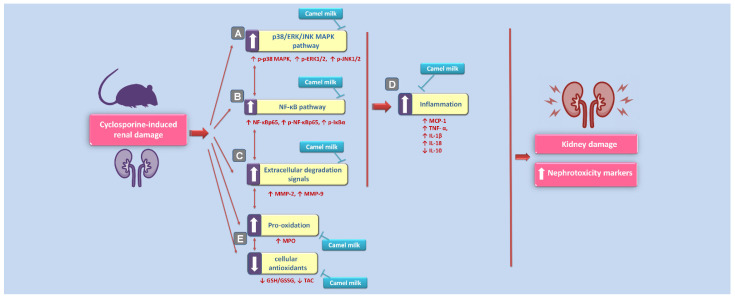Figure 9.
An overview of the suggested molecular mechanisms that interceded the beneficial impact of camel milk in cyclosporine-evoked renal injury. According to the current findings, the proposed mechanisms pertaining to the attenuation of cyclosporine-evoked nephrotoxicity are: (A) Camel milk inhibited the upstream pro-inflammatory p38/ERK/JNK MAPK pathway, as revealed by lowered phosphorylation of the three subfamilies of MAPK (p38 MAPK, ERK1/2, and JNK1/2). (B) Meanwhile, camel milk inhibited the activation of the pro-inflammatory NF-κB pathway, as seen by downregulated expression of activated NF-κBp65 alongside p-NF-κBp65 and p-IκBα proteins. (C) Camel milk lowered the renal expression of the extracellular degradation signals matrix metalloproteinases (MMP-2 and MMP-9). (D) Camel milk inhibited renal inflammation, as evidenced by lowered renal levels of MCP-1, TNF-α, IL-1β, and IL-18 pro-inflammatory cytokines and enhanced the production of the anti-inflammatory signal IL-10. (E) The curtailing of renal oxidative stress and augmentation of the antioxidant capacity also contributed to the amelioration of cyclosporine-evoked renal damage. The blunt arrows indicate inhibition, and the solid arrows indicate activation.

